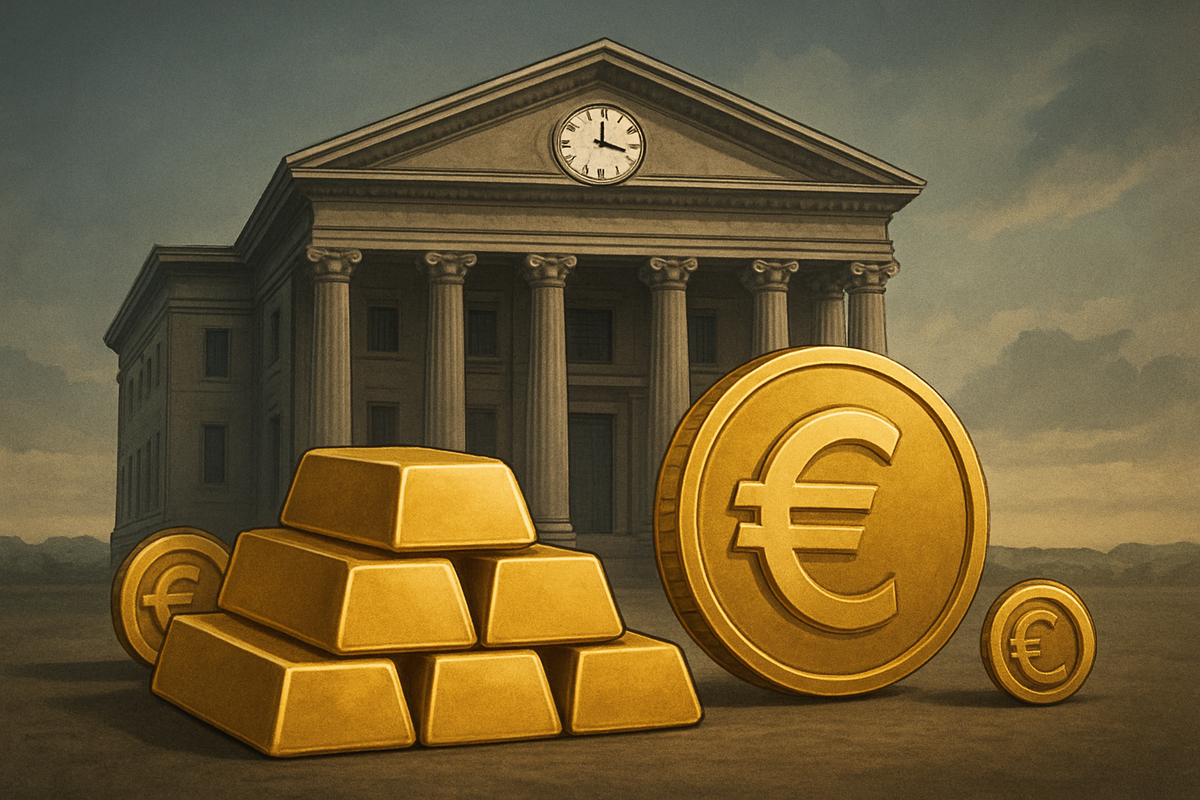
The financial markets are closely scrutinizing the latest move from the European Central Bank (ECB), which, on October 30, 2025, opted to leave its key interest rates unchanged for the third consecutive meeting. This decision, largely anticipated by analysts, marks a period of stability following an aggressive series of rate cuts earlier in the year. Intriguingly, even as the ECB maintains its current monetary policy stance, the gold market is holding on to solid gains against the euro, signaling a complex interplay of forces at work.
This stability in euro interest rates, coupled with gold's robust performance, highlights the nuanced relationship between central bank decisions, currency valuations, and the appeal of safe-haven assets. Investors are now keenly observing how this equilibrium will impact the broader Eurozone economy and the strategic positioning of various public companies in the coming months.
ECB's Steady Hand: A Pause After Aggressive Easing
The European Central Bank's Governing Council, meeting on October 30, 2025, confirmed its decision to keep the three key interest rates unchanged. The deposit facility rate remains at 2.00%, the main refinancing operations rate at 2.15%, and the marginal lending facility rate at 2.40%. This marks a significant pivot from the preceding period, which saw the ECB engage in an extensive easing cycle, implementing eight rate cuts totaling 200 basis points between June 2024 and June 2025. This aggressive easing brought the deposit facility rate down from 4.00% in September 2023 to its current level. The rate-cutting trend began after a period of significant hikes in 2022 and 2023 aimed at combating surging inflation, with the ECB pausing its adjustments in July 2025 once inflation returned close to its target.
The rationale behind the ECB's decision to hold rates steady is primarily rooted in its assessment that inflation is now close to its 2% medium-term target. Despite a slight uptick in eurozone headline inflation to 2.2% year-on-year in September 2025 (with core inflation at 2.3%), these figures were broadly in line with expectations. The ECB's staff projections anticipate headline inflation to average 2.1% in 2025, easing to 1.7% in 2026, and rising slightly to 1.9% in 2027. Core inflation is projected at 2.4% in 2025, 1.9% in 2026, and 1.8% in 2027.
Furthermore, the Governing Council noted the continued resilience of the Eurozone economy, which expanded by 0.2% in the third quarter of 2025, surpassing analyst expectations. This resilience is attributed to a robust labor market, solid private sector balance sheets, and the cumulative impact of previous interest rate reductions. However, the ECB acknowledged persistent uncertainties, including ongoing global trade disputes and geopolitical tensions. The Governing Council reaffirmed its commitment to the 2% inflation target and emphasized a "data-dependent and meeting-by-meeting approach," refraining from pre-committing to any future rate path.
In terms of immediate market reactions, the euro (EUR) saw an increase in value leading up to the decision, as the market widely anticipated the rates to remain unchanged. Analysts suggested that the ECB's reinforced stance, indicating the rate-cutting cycle is likely complete for now, could help the EUR/USD exchange rate regain upward momentum, especially given expectations of potential continued easing by the U.S. Federal Reserve. The gold (XAU) market, conversely, reportedly maintained solid gains against the euro despite the ECB's steady rates. However, some reports indicated that gold prices were more influenced by broader global monetary policy expectations, particularly a dimmed outlook for further rate cuts from the U.S. Federal Reserve, rather than being solely driven by the ECB's specific decision.
Corporate Fortunes: Winners and Losers in a Stable Rate, Strong Gold Environment
The European Central Bank's decision to maintain stable interest rates, juxtaposed with gold's robust performance against the euro, creates a distinct landscape of winners and losers across various sectors, particularly impacting gold mining companies, European financial institutions, and investment firms.
Gold mining companies stand to be significant beneficiaries in this environment. A strong gold price denominated in Euros directly translates into elevated revenues and enhanced profit margins for these producers. The Euro gold price has seen substantial appreciation, increasing over 110% in the last five years and more than 767% over two decades, with notable gains in the past year alone. This upward trajectory is amplified by the inherent operating leverage in mining, where revenue growth outpaces cost increases when commodity prices rise. Stable ECB interest rates provide predictability regarding financing and debt, crucial for funding capital-intensive activities like exploration and mine development. If these stable rates are at a low level, they further reduce the cost of capital, encouraging investment and growth. Publicly traded companies like Agnico Eagle Mines (NYSE: AEM), a Canadian producer with operations in Finland, and Kinross Gold (NYSE: KGC), another Canadian miner with a global footprint, are well-positioned. Similarly, Endeavour Mining (LSE: EDV), though focused on West Africa, is listed on the London Stock Exchange and benefits from strong gold prices, as does Fresnillo Plc (LSE: FRES), a Mexican precious metals company also listed in London. These firms are incentivized to expand exploration and boost production, potentially reactivating previously uneconomical mines.
Conversely, European financial institutions, predominantly banks, face a more nuanced impact. Stable ECB interest rates, especially when transitioning from very low or negative rates to more normalized levels (around 2% for the deposit facility rate), are generally positive for banks' net interest income in the short term. This stability can help mitigate margin compression. Predictable rates also offer certainty for both borrowers and lenders, potentially boosting bank lending volumes if rates are supportive. However, if stable rates are perceived as high, loan growth might slow due to increased borrowing costs, and while higher rates can enhance Net Interest Margin (NIM), they might also increase credit risk over time as borrowers face higher debt servicing costs. A strong gold price against the euro can stimulate demand for gold-related investment products, generating fee income for banks. However, the ECB has cautioned about potential risks in gold markets, particularly concerning derivatives, citing increased exposure, possible delivery bottlenecks, counterparty risks, and liquidity issues from leveraged positions. Gross notional exposures to gold derivatives in the Euro area reached €1 trillion in March 2025, with a significant portion involving bank counterparties, highlighting potential systemic risks. Major European banks like HSBC Holdings plc (LSE: HSBC), BNP Paribas SA (EPA: BNP), Deutsche Bank AG (ETR: DBK), UBS Group AG (SWX: UBSG), Credit Agricole SA (EPA: ACA), Banco Santander SA (BME: SAN), Société Générale SA (EPA: GLE), and ING Group NV (AMS: INGA) will need to carefully navigate these dynamics.
Investment firms are also directly influenced. Stable, low-for-longer interest rates can encourage these firms to seek higher yields, potentially leading to increased allocation to riskier assets or greater leverage, which can heighten portfolio instability during market volatility. Conversely, stable, moderate rates might foster more balanced portfolio approaches. A strong Euro-denominated gold price increases gold's appeal as an asset, prompting investment firms to boost their direct holdings (physical gold, ETFs) or indirect exposure (gold mining stocks). Gold's perception as a safe-haven asset, especially amidst geopolitical risks or economic uncertainties, drives demand from investors and central banks, leading to new product development and associated management fees. However, the associated derivatives market activity introduces risks, particularly concerning margin calls and liquidity shortfalls. Prominent European investment firms such as Amundi Asset Management (EPA: AMUN) (part of Crédit Agricole), Allianz Global Investors (part of Allianz SE, ETR: ALV), DWS Group (ETR: DWS) (part of Deutsche Bank), Legal & General Investment Management (part of Legal & General Group Plc, LSE: LGEN), Schroders plc (LSE: SDR), AXA Investment Managers (part of AXA SA, EPA: CS), BNP Paribas Asset Management (part of BNP Paribas), Natixis Investment Managers (part of BPCE), and UBS Asset Management (part of UBS Group) will need to adjust their strategies accordingly.
Wider Significance: Navigating Global Crosscurrents
The European Central Bank's decision to hold interest rates steady on October 30, 2025, for the third consecutive meeting, is a strategic move reflecting a cautious optimism regarding the Eurozone economy's resilience amidst significant global uncertainties. This policy stability, coming after an aggressive easing cycle, is particularly significant when juxtaposed with gold's robust performance against the euro, revealing a complex interplay of economic fundamentals, geopolitical risks, and evolving market sentiment.
This policy stance aligns with a broader trend of central banks attempting to normalize monetary policy after periods of extreme easing or tightening, while remaining data-dependent. Eurozone headline inflation, at 2.0% in Q2 and 2.1% in Q3 2025, is near the ECB's 2% medium-term target, with forecasts for October 2025 hovering around 2.1-2.2%. The Eurozone economy itself expanded by 0.2% quarter-on-quarter in Q3 2025, exceeding analyst expectations. However, this growth, while positive, is somewhat subdued beneath the surface, heavily influenced by strong performance in specific member states like Ireland. Globally, the economic outlook for late 2025 is characterized by resilience tempered by unease, with geopolitical risks, structural divergences, and trade frictions weighing heavily. Global growth is projected to decelerate, with the United States showing surprising strength while the Euro area struggles for significant momentum. Persistent geopolitical tensions, including ongoing conflicts in Eastern Europe and the Middle East, coupled with US-China trade disputes and cybersecurity threats, continue to fuel policy uncertainty and dampen global investment and trade.
The persistent strength of gold against the euro throughout 2025 is a critical indicator of deeper market anxieties. Gold crossed the €3,000 per ounce barrier by early 2025 and saw futures prices surge by 46% by September. This robust performance is primarily driven by elevated geopolitical uncertainty, making gold an attractive safe-haven asset. Furthermore, a weakening US dollar, influenced by concerns about the US economy and narrowing interest rate differentials, has made gold more appealing to international buyers, including those holding euros. Crucially, central banks worldwide, notably China, have significantly increased their gold holdings to diversify risk away from the dollar and as a hedge against global instability, providing strong underlying support for gold prices. While Eurozone inflation is near target, the global context of persistent inflation maintains gold's appeal as an inflation hedge.
The ripple effects of the ECB's steady rate policy and strong gold are multifaceted. Currency dynamics could see the euro potentially strengthen, further dampening Eurozone inflation by making imports cheaper, though the US dollar's global dominance is expected to persist. Divergent policy paths or expectations between major central banks, such as the ECB and the US Federal Reserve (which also faces persistent inflation), could lead to increased currency volatility. Global trade disputes and US tariffs continue to be a significant source of uncertainty for the Eurozone, potentially hindering exports and private investment. For financial institutions, a stable, predictable interest rate environment reduces interest rate risk, but subdued growth, even with stable rates, could still challenge profitability if credit demand remains weak. From a regulatory perspective, there is a growing emphasis on public spending for growth and defense, necessitating careful fiscal consolidation. Europe's financial system also faces structural shortcomings, with a push to embed financial competitiveness as a regulatory objective. Upcoming regulatory changes include AIFMD II legislation (effective April 2026) for alternative investment funds, the EU ESG Ratings Regulation (July 2026) to combat "greenwashing," and the implementation of T+1 settlement by 2027 to boost operational efficiencies across European markets. Historically, gold and interest rates often exhibit an inverse correlation, where falling rates make non-yielding gold more attractive. However, in the current scenario, gold's strong performance, despite stable ECB rates, is explained by the confluence of recent rate cuts (June 2024-June 2025), high geopolitical uncertainty, a weakening US dollar, and robust central bank demand, overriding the traditional dampening effect that stable, non-zero interest rates might otherwise have.
What Comes Next: Navigating the Future of Eurozone Monetary Policy and Gold's Trajectory
The European Central Bank's decision to hold interest rates steady on October 30, 2025, signals a pivotal moment for the Eurozone economy, setting the stage for a period of cautious observation and data-dependent policy. This stability, following an aggressive easing cycle, will shape the short-term and long-term possibilities for monetary policy, with significant implications for gold and the euro.
In the short term (the next 6-12 months), the prevailing market expectation is that the ECB will maintain its current interest rates "for the foreseeable future" and "well into 2026," with no further cuts anticipated in 2025. This stance is supported by ECB staff projections that foresee headline inflation averaging 2.1% in 2025, dipping to 1.7% in 2026, and then rising slightly to 1.9% in 2027, with services inflation remaining a key driver. Future policy decisions will remain heavily reliant on incoming economic data, particularly concerning inflation dynamics and the effectiveness of monetary policy transmission. While some analysts suggest a minor dovish bias for potential rate adjustments in 2026, the general consensus is that a high bar for further cuts exists, requiring substantial downside risks to the economic outlook. Potential triggers for additional easing could include an unexpected weakening of the Eurozone economy, a significant appreciation of the euro, delayed adverse effects from US tariffs, or renewed political instability. For now, the ECB is expected to maintain a "neutral stance," aiming to anchor inflation expectations around its 2% target.
Looking further ahead, the ECB's monetary policy framework has undergone strategic evolution to navigate a post-inflation environment marked by structural uncertainties. A key long-term pivot is the explicit adoption of a symmetric 2% inflation target, meaning deviations both above and below this threshold will be addressed equally. The ECB has also broadened its toolkit to address both inflationary and deflationary shocks, considering structural challenges like geopolitical fragmentation, climate risks, and technological disruptions. A significant strategic initiative is the development of a digital euro, with a pilot launch aimed for mid-2027 and a full-scale rollout planned for 2029, pending legislative approvals, to enhance the Eurozone's financial autonomy. While not a near-term expectation, one central bank governor has even suggested an "equal chance" for either a rate cut or a hike as the ECB's next long-term move, indicating the Governing Council's readiness to respond to evolving economic conditions. Broader challenges for Europe include enhancing economic competitiveness through widespread reforms to reduce bureaucracy and foster increased investment and innovation.
These dynamics create various market opportunities and challenges. Sustained low interest rates (around 2%) are expected to continue stimulating economic growth and provide potential support for equity markets into 2026. However, in a deeper economic slowdown scenario, defensive sectors such as utilities or consumer staples might present opportunities, while cyclical sectors or those with significant debt could face ongoing challenges. Divergent monetary policies among major global economies could lead to increased currency volatility and imbalances in capital flows. German Bund yields have risen to 2.925% in 2025, establishing a new norm for elevated term premiums.
For gold, the relationship with interest rates is traditionally inverse. While the ECB's steady rates may mute direct upward pressure, gold prices did recover on October 30, 2025, rising 0.8% to $3,961 per ounce, potentially influenced by the fading impact of the Federal Reserve's recent rate cut and a weakening US dollar. Should global trade disputes, geopolitical tensions, or other economic uncertainties escalate, gold's traditional role as a safe-haven asset could bolster demand, driving prices higher. The ECB's acknowledgment of concerns that a surge in demand for physically settled gold contracts could threaten Eurozone financial stability underscores gold's function as a barometer of financial stability and could lead to increased long-term bullish sentiment for physical gold if systemic risks intensify.
The euro's value will be significantly influenced by interest rate differentials, economic data, and geopolitical developments. The anticipated neutral stance from the ECB is expected to limit the euro's downside potential. A more hawkish communication from the ECB than currently anticipated could lead to further gains for the euro, while any dovish surprises could weaken it. Stronger-than-expected inflation or robust economic growth data would generally support the currency. The EUR/USD currency pair will experience significant volatility driven by ECB announcements and any divergence in monetary policy with the US Federal Reserve. Ongoing global trade disputes and geopolitical tensions also introduce uncertainty, which could weigh on the Eurozone economy and, consequently, the euro.
Comprehensive Wrap-up: A Steady Course Amidst Global Currents
The European Central Bank's decision on October 30, 2025, to maintain its key interest rates unchanged for the third consecutive meeting marks a period of deliberate stability following an extensive easing cycle. With the deposit facility rate at 2.00%, the main refinancing operations rate at 2.15%, and the marginal lending facility rate at 2.40%, the ECB signals confidence in the Eurozone's disinflationary process and economic resilience, even as it navigates a complex global landscape.
The key takeaway from this decision is the ECB's comfort with inflation hovering near its 2% medium-term target, coupled with a Eurozone economy that continues to exhibit growth, albeit cautiously, supported by a robust labor market. This "wait and see" approach underscores a commitment to data-dependency, providing flexibility to respond to evolving economic and financial conditions without pre-committing to future rate paths. However, the lingering shadows of global trade disputes and geopolitical tensions continue to cast uncertainty over the outlook. Intriguingly, despite the ECB's steady hand, gold has maintained solid gains against the euro, highlighting its enduring role as a safe-haven asset in times of global instability, a weakening US dollar, and robust central bank demand.
Moving forward, the market anticipates the ECB to largely maintain its current rates "for the foreseeable future," possibly well into 2026, with a high bar for any further cuts. This stability is expected to support equity markets, though defensive sectors might offer opportunities in a deeper economic slowdown. The euro's value will be sensitive to interest rate differentials, economic data, and any divergence in monetary policy with other major central banks, particularly the US Federal Reserve. For gold, its performance will likely continue to be driven by geopolitical developments and its traditional safe-haven appeal, potentially overriding the direct influence of stable ECB rates. The ECB's long-term strategic pivots, including the development of a digital euro, signal a forward-looking approach to enhancing the Eurozone's financial autonomy and resilience.
The lasting impact of this period of stable rates will hinge on the sustained trajectory of inflation and economic growth, alongside the resolution or escalation of global trade and geopolitical tensions. Investors should closely monitor ECB communications, particularly any shifts in rhetoric from President Christine Lagarde, and upcoming Eurozone economic data—especially core inflation, wage growth, and GDP reports. Developments in global trade policy, particularly the U.S. tariff regime and U.S.-China relations, will also be critical. Furthermore, the progress of the digital euro project and the monetary policy paths of other major central banks will be crucial for understanding currency dynamics and global capital flows in the months to come. The current environment underscores that gold's price is shaped by a multifaceted array of economic, political, and sentiment-driven factors, extending beyond mere interest rate movements, making it a vital asset to watch in an increasingly volatile world.
This content is intended for informational purposes only and is not financial advice






